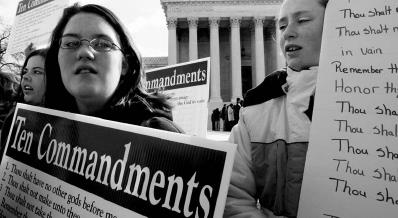The Rehnquist Court (1986–2005)Freedom of Religion |
Can the Ten Commandments be posted on government property? |
There remains a sharp dispute over this matter even after two U.S. Supreme Court decisions on this subject by the Rehnquist Court in June 2005. The Burger Court had ruled 5–4 in Stone v. Graham that a Kentucky law requiring the posting of the Ten Commandments in public school classrooms violated the Establishment Clause. The ruling focused on the special environment of the school and the impressionable young ages of the viewers (the students). Lower courts continued to divide over the constitutionality of the posting of the Ten Commandments on other government property. On June 27, 2005, the Court issued 5–4 decisions in Van Orden v. Perry and McCreary County, KY. v. ACLU of Kentucky.
In Van Orden, the Court ruled that a Ten Commandments monument on government property did not violate the Establishment Clause. In his plurality opinion, Chief Justice William Rehnquist noted that there were twenty-one historical markers and seventeen monuments surrounding the Texas state capital, that the monument was placed there in 1961, and that even the challenger had walked by the monument for many years before filing a lawsuit. Rehnquist also noted the large number of government buildings in Washington, D.C., that contained religious displays or monuments. “We need only look within our own Courtroom,” the chief justice wrote. “Since 1935, Moses has stood, holding two tablets that reveal portions of the Ten Commandments written in Hebrew, among other lawgivers in the south frieze.”
In McCreary, the Court ruled that Ten Commandment displays in two Kentucky county courthouses did violate the Establishment Clause. Justice David Souter wrote the Court’s plurality opinion, finding that the display in the courthouse violated the Establishment Clause. He noted that initially the Ten Commandments plaque was placed by itself in the courthouse: “When the government initiates an effort to place this statement alone in public view, a religious object is unmistakable.” The decisions seem to indicate that context, history, and the purpose behind the placing of the Ten Commandments are key factors. A look at the Court’s decisions shows that eight justices ruled the same way in each case, with Justice Stephen Breyer providing the key fifth vote in both cases. It may well take more litigation to clarify the constitutionality of such displays.

